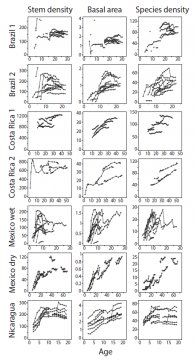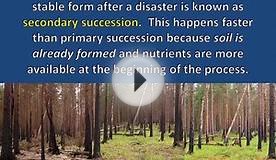What is secondary ecological succession?
Over the last few years I have written quite a lot about forest succession. I have published a paper on the topic, have a paper in review about recovery of a forest under multiple stressors and will be starting more work on the it over the next few weeks. All in all, I think I have a reasonable idea what I’m talking about when it comes to succession, at least in forests. However, I’ve just read a paper on tropical forest succession that caught me a bit unawares*.
The paper in question is Natalia Norden and colleagues’ work that was recently published in PNAS. The authors collected data from 72 secondary forest plots monitored for 7-24 years at 7 different sites across tropical South and Central America. They then used this data to look whether we can predict trajectories plot stem density, basal area and species density during forest succession after total clearance. On the whole the paper found that trajectories were poorly predicted by models that looked at change as a function of forest age. From the figure below, you can pick some general trends in the direction of change with age – stem density might have a humped relationship with age for example. However, it is also clear that there is a huge amount of variation and some trajectories bounce around all over the place.

It’s obvious from looking at the figure above that the age of a secondary forest doesn’t really act as a proxy for its successional stage. In fact Norden and colleagues found that on average age only explains 20% of within site variation. Even if that is better than the average ecology paper, it’s still not very good. To explain the rates of change of different variables, Norden et al. fitted a set of different non-linear models for each site. Again, their findings emphasised the large amount of variation between different sites. Due to these idiosyncrasies, the authors of the paper see space-for-time substitution as a flawed method for predicting the dynamics of forests. They also suggest that such approaches should not be used for studies of succession of any sort of vegetation, arguing that previous work these methods has made succession appear as if it is deterministic, and it is not.

